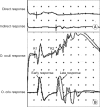Electrophysiologic investigation during facial motor neuron suppression in patients with hemifacial spasm: possible pathophysiology of hemifacial spasm: a pilot study
- PMID: 24466519
- PMCID: PMC3895524
- DOI: 10.5535/arm.2013.37.6.839
Electrophysiologic investigation during facial motor neuron suppression in patients with hemifacial spasm: possible pathophysiology of hemifacial spasm: a pilot study
Abstract
Objective: To evaluate the pathophysiological mechanism of hemifacial spasm (HFS), we performed electrophysiological examinations, such as supraorbital nerve stimulation with orbicularis oris muscle recording and lateral spread tests, after suppressing the patient's central nervous system by administering intravenous diazepam.
Methods: Six patients with HFS were recruited. Supraorbital nerve stimulation with orbicularis oris muscle recording and the lateral spread test were performed, followed by intravenous application of 10 mg diazepam to achieve facial motor neuron suppression. Subsequently, we repeated the two electrophysiological experiments mentioned above at 10 and 20 minutes after the patients had received the diazepam intravenously.
Results: Orbicularis oris muscle responses were observed in all patients after supraorbital nerve stimulation and lateral spread tests. After the diazepam injection, no orbicularis oris muscle response to supraorbital nerve stimulation was observed in one patient, and the latencies of this response were evident as a slowing tendency with time in the remaining five patients. However, the latencies of the orbicularis oris muscle responses were observed consistently in all patients in the lateral spread test.
Conclusion: Our results suggest that ectopic excitation/ephaptic transmission contributes to the pathophysiological mechanisms of HFS. This is because the latencies of the orbicularis oris muscle responses in the lateral spread test were observed consistently in the suppressed motor neuron in our patients.
Keywords: Blinking; Diazepam; Electromyography; Hemifacial spasm; Pathophysiology.
Conflict of interest statement
No potential conflicts of interest relation to this article was reported.
Figures


Similar articles
-
Blink reflexes and lateral spreading in patients with synkinesia after Bell's palsy and in hemifacial spasm.Eur Neurol. 2000;43(3):141-6. doi: 10.1159/000008153. Eur Neurol. 2000. PMID: 10765053
-
Electrophysiological study of ephaptic axono-axonal responses in hemifacial spasm.Muscle Nerve. 2007 Feb;35(2):184-8. doi: 10.1002/mus.20674. Muscle Nerve. 2007. PMID: 17058273
-
The effects of botulinum toxin A on ephaptic transmission in idiopathic hemifacial spasm.Int J Neurosci. 2009;119(11):2044-55. doi: 10.1080/00207450903139705. Int J Neurosci. 2009. PMID: 19863260 Clinical Trial.
-
Electrophysiology of the facial nerve in hemifacial spasm: ectopic/ephaptic excitation.Muscle Nerve. 1985 Sep;8(7):545-55. doi: 10.1002/mus.880080702. Muscle Nerve. 1985. PMID: 2995804 Review.
-
Facial nerve palsy and hemifacial spasm.Handb Clin Neurol. 2013;115:367-80. doi: 10.1016/B978-0-444-52902-2.00020-5. Handb Clin Neurol. 2013. PMID: 23931790 Review.
Cited by
-
The glabella tap reflex reveals fluctuations in the hyperexcitability of the facial nucleus with hemifacial spasm: a prospective observational study.Neurosurg Rev. 2025 Aug 19;48(1):609. doi: 10.1007/s10143-025-03777-7. Neurosurg Rev. 2025. PMID: 40828430
-
Independent episodes of vestibular paroxysmia and hemifacial spasm duo to a distorted vertebral artery in one patient.Acta Neurol Belg. 2024 Oct;124(5):1679-1681. doi: 10.1007/s13760-023-02229-7. Epub 2023 Apr 25. Acta Neurol Belg. 2024. PMID: 37097397 No abstract available.
-
Role of neuroimaging in cases of primary and secondary hemifacial spasm.Indian J Ophthalmol. 2021 Feb;69(2):253-256. doi: 10.4103/ijo.IJO_415_20. Indian J Ophthalmol. 2021. PMID: 33463567 Free PMC article.
-
Hemifacial spasm and neurovascular compression.ScientificWorldJournal. 2014;2014:349319. doi: 10.1155/2014/349319. Epub 2014 Oct 28. ScientificWorldJournal. 2014. PMID: 25405219 Free PMC article. Review.
-
Is the pre-operative lateral spread response on facial electromyography a valid diagnostic tool for hemifacial spasm?Neurosurg Rev. 2021 Dec;44(6):3259-3266. doi: 10.1007/s10143-020-01267-6. Epub 2021 Feb 9. Neurosurg Rev. 2021. PMID: 33559796
References
-
- Nielsen VK. Pathophysiology of hemifacial spasm: I. Ephaptic transmission and ectopic excitation. Neurology. 1984;34:418–426. - PubMed
-
- Auger RG. Hemifacial spasm: clinical and electrophysiologic observations. Neurology. 1979;29(9 Pt 1):1261–1272. - PubMed
-
- Maroon JC. Hemifacial spasm: a vascular cause. Arch Neurol. 1978;35:481–483. - PubMed
-
- Jannetta PJ, Abbasy M, Maroon JC, Ramos FM, Albin MS. Etiology and definitive microsurgical treatment of hemifacial spasm. Operative techniques and results in 47 patients. J Neurosurg. 1977;47:321–328. - PubMed
-
- Moller AR. Interaction between the blink reflex and the abnormal muscle response in patients with hemifacial spasm: results of intraoperative recordings. J Neurol Sci. 1991;101:114–123. - PubMed
LinkOut - more resources
Full Text Sources
Other Literature Sources

